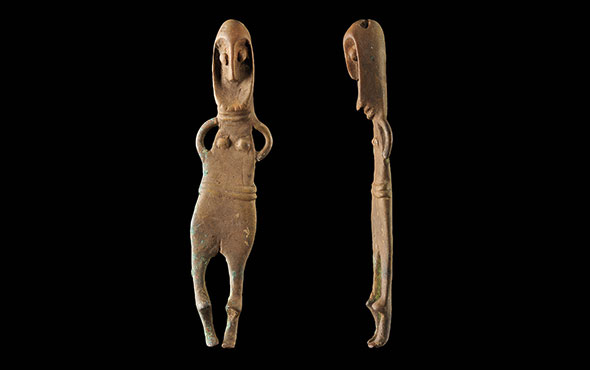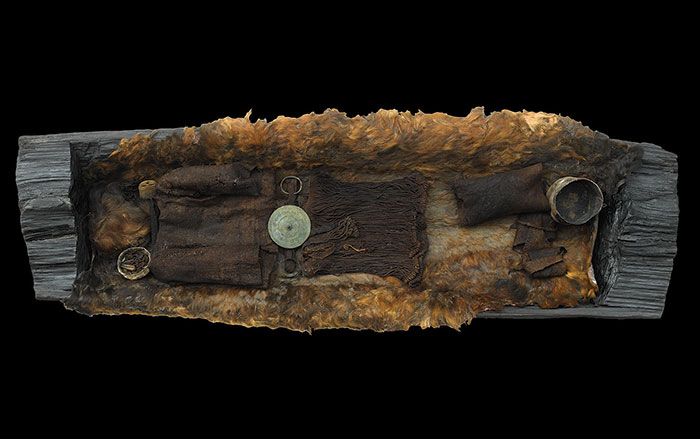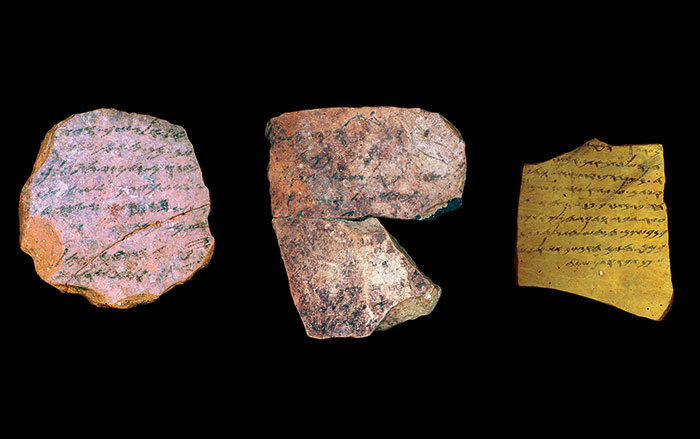
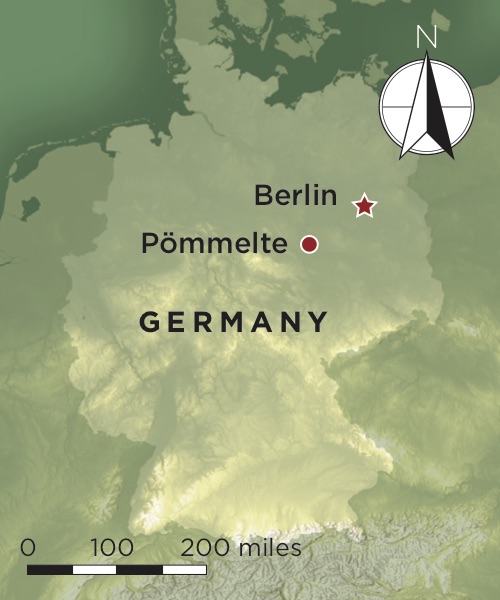
In the middle of a potato field not far from the small village of Pömmelte in central Germany, University of Halle archaeologist Franziska Knoll unrolls a five-foot-long piece of paper and tapes it to the graffiti-streaked side of a shipping container full of recently excavated artifacts. A set of concentric circles fills one corner of the paper. Under that, dozens of rectangles, all oriented in the same direction, march along the length of the page. The blueprint is the fruit of three years of excavation that has involved everything from earthmoving equipment to tweezers. The dig’s scale is hard to fathom. In 2020 alone, a 15-person team from the State Office for Heritage Management and Archaeology Saxony-Anhalt excavated more than six acres, in trenches as long as several football fields laid end to end.
Knoll has to raise her voice to talk over the rumbling of a 28-ton Caterpillar 323 excavator carving a new trench nearby. The rectangles on the paper, she explains, represent the outlines of dozens of houses, traces of a settlement that thrived here at the dawn of the Bronze Age. The circles represent the remains of a large wooden sanctuary that was built at the same time as the neighboring village. “It’s the largest Early Bronze Age settlement we know of in Central Europe,” Knoll says. “We’ve found sixty-five houses so far. This must have been a really significant place.”
The excavator’s operator maneuvers the machine’s metal bucket to scrape away a foot or so of dirt at a time while one of Knoll’s team members in a hard hat and steel-toed boots keeps a close eye on the soil. He is looking for dark patches that contrast against the light-brown soil—the decomposed remnants of wood posts sunk into the earth more than 4,000 years ago. When he spots one, he marks the posthole with a metal spike and fluorescent pink spray paint so it can be precisely mapped and, later, carefully excavated.

Unspectacular as the postholes at Pömmelte may appear, their discovery has the potential to resonate far beyond central Germany. The results of excavations here over the last 15 years suggest that the site is closely linked to Stonehenge. Knoll argues that Stonehenge and Pömmelte, or, as she calls it, Woodhenge, are in fact siblings. She thinks the wooden structure may perhaps even have been built by people who had visited the better-known British monument. Hers is a view of Europe’s distant past that wouldn’t have been possible 30 years ago. Pömmelte is located in the state of Saxony-Anhalt, which, until 1990, was part of East Germany. Under Communist rule, aerial surveys were not possible, but the fall of the Iron Curtain and Germany’s reunification opened up a new era of archaeology in eastern Germany. For the first time, comprehensive aerial surveys allowed archaeologists to search for traces of structures invisible at ground level. Because the disturbed soil in ancient ditches or pits holds more moisture, crops planted there grow taller and greener, and the footprints of ancient structures show up as swaths of darker plants in the middle of farm fields.
Aerial photos taken in 1991 revealed the existence of Pömmelte’s posthole rings, along with almost a dozen similar enclosures in the region. Preliminary excavations showed that most had been built in the Neolithic period, about 7,000 years ago, or perhaps even earlier. Until excavations at Pömmelte began in 2005, archaeologists assumed it, too, predated the Bronze Age by millennia. “We didn’t think it was possible to have a Bronze Age ring here,” Knoll says. “We assumed they were all much older.” But not only was the ring at Pömmelte much bigger than the region’s other rings, test excavations confirmed that it was also much younger, with radiocarbon dates placing its earliest phases around 2300 B.C. That put it squarely at the end of the late Neolithic or beginning of the Early Bronze Age, an era of transition that began in the fourth millennium B.C. and saw innovations such as metalworking, the development of social hierarchies, and the wheel spread across Europe.
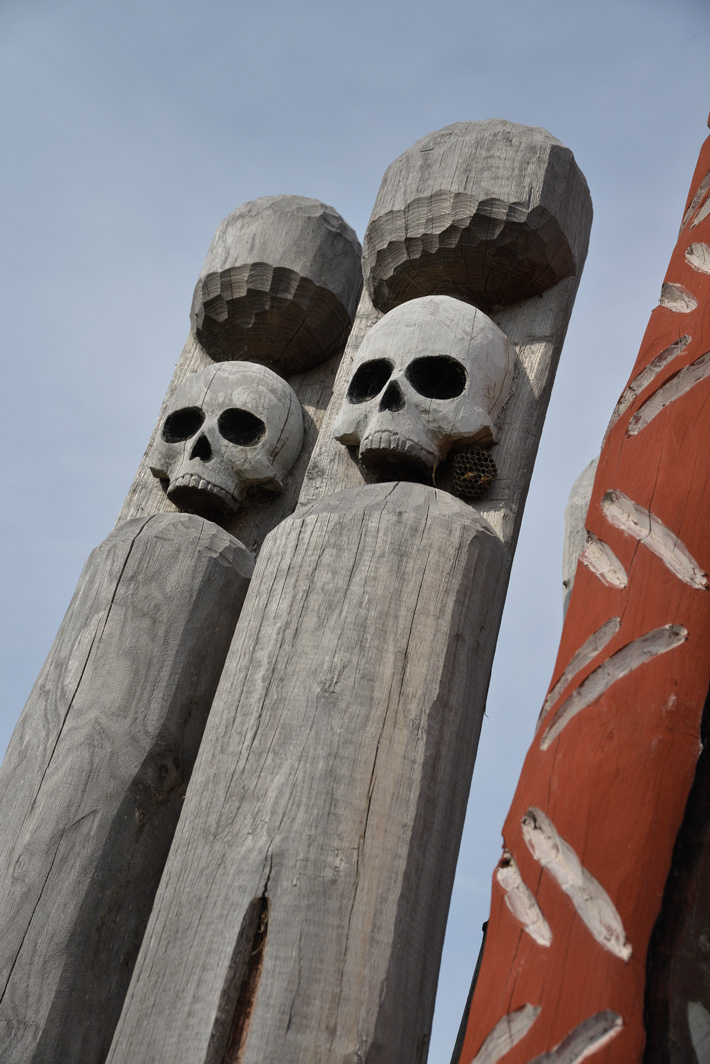
These dates prompted project archaeologists to fully excavate the structure in 2005. As they dug deeper, they were stunned at what they found. Their excavations exposed not only concentric rings constructed of oak posts, but also dozens of graves and pits filled with sacrifices and offerings. “What was surprising was the complexity—the complexity of the structure itself, and the complexity of the findings that definitely indicated the site was a sanctuary,” says archaeologist André Spatzier of the State Office for Cultural Heritage Management Baden-Württemberg, who led the initial excavations.
By documenting the postholes, archaeologists were able to reconstruct the sanctuary’s dimensions. Its outer circle is about 130 yards across, and an inner palisade of closely set logs forms a sort of enclosed inner sanctum. A few years ago, local authorities recreated the ring, placing black locust logs in the exact spots archaeologists had identified postholes. They also added some imaginative embellishments. Since nothing but the decayed bases of the logs has been uncovered, the decorations seen today—geometric patterns in red and black, carved animal shapes, and even a few carved human skulls—are purely speculative. Even so, wandering among the 10-foot-tall posts gives visitors a sense of just how large the Bronze Age sanctuary was. From atop an observation platform that offers a sweeping view of the reconstructed sanctuary and the surrounding countryside, the effort that must have gone into building and maintaining the site becomes evident. “That’s a lot of work,” Knoll says. “Somebody must have ordered it, and it’s not a project for ten or twenty or even one hundred people. It’s a society-wide effort.”
About a half mile away from the Pömmelte ring, another excavator and a few white vans are parked. There, it’s possible to spy archaeologists working at a smaller ring sanctuary called Schönebeck, where excavations have just begun. Knoll says Pömmelte and Schönebeck were probably linked via a ceremonial pathway, forming a larger ritual landscape similar to the one that sprawls around Stonehenge.
Twenty-nine pits in Pömmelte’s main sanctuary’s outer circle hint at what went on inside the rings, where hundreds of people could have gathered. Some of the six-foot-deep pits contained drinking vessels and cow bones with cut marks. Others were filled with stone axes and grindstones. Archaeologists also found a handful of miniature ceramic vessels, along with the shattered fragments of larger pots and drinking cups. Still other pits had more grisly contents—researchers uncovered the skeletons of women and children, some with marks on their bones indicating they died violently. One woman had her hands behind her back, as though she had been bound. “The fact that they were put in these pits suggests that was also part of a ritual somehow,” Knoll says.
Around 2050 B.C., the last ceremonies were held at Pömmelte after it had been used for about 300 years. What happened then is unclear, although the presence of charred wood points to the outbreak of a major fire. “The ring burned or was burned,” Knoll says. “But there are no mass graves, no signs of an attack. And they wouldn’t have just left it behind.” After a blaze that must have lit the night sky for miles around, what was left of the burned posts was pushed into the ring’s trenches and covered over, likely as part of a planned ceremony or event.

In the course of her current excavations, Knoll and her team have reopened excavations at the site in the hopes of understanding why the rituals at Pömmelte ceased. The people who erected the first posts were part of the widespread Bell Beaker culture, named for their distinctive pottery made between 2800 and 2300 B.C. found at sites from Ireland in the West to Bohemia and Poland in the East, and south all the way to the tip of Spain. During the Bell Beaker period, metal artifacts began to become more common and to replace the stone tools of previous eras. At the same time, people’s houses became larger and settlement styles began to change. Bell Beaker burials appear similar all over Europe, and often contain weapons, including daggers and bows, along with stone wrist guards. But by the time the ring was dismantled, the Bell Beaker period was over at Pömmelte.
The world around Pömmelte had changed, too. Nearby excavations of grave mounds and settlements show that by 2000 B.C., metal was even more common, and the area had become more interconnected, with village chiefs and local clans united under powerful leaders. Rather than spending their resources on ring sites that served the region’s broader population, communities started pouring them into massive grave mounds for Bronze Age princes, their oak-walled burial chambers filled with gold and bronze finery—similar to the large mounds, or barrows, created at Stonehenge around the same time. “It’s clear that the sacral landscape flourished between 2400 and 2000 B.C., and then it came to an end,” Spatzier says. “We see the rise of Early Bronze Age elites at the same time. It’s not a coincidence.”
According to University of Southampton archaeologist Joshua Pollard, something similar happened in Britain. “We find a very similar sequence with Stonehenge,” says Pollard, who has been excavating sites near the monument for more than a decade. “As we go into the Early Bronze Age, we see increasing numbers of people buried within the landscape and the creation of big barrow graves. But, by the time you hit 1600 B.C., there’s no more construction or meaningful activity at the site.”
Though Stonehenge’s massive stone pillars are world-famous and it’s only possible to reconstruct Pömmelte from stains in the soil, the German sanctuary actually has something Stonehenge doesn’t, at least thus far. For 300 years, a sizable village thrived next door. Archaeologists from the University of Halle have spent several months each summer for the past five years uncovering traces of this ancient settlement.

Over more than 3,000 years, Knoll explains, a foot or more of topsoil has disappeared from the settlement site as a result of intensive farming and taken the floors of the ancient longhouses with it. Because so little is left on the surface, Knoll and her team can open up huge swaths of the site using an excavator without worrying about disturbing hidden artifacts. “We’ve lost that top layer, so we don’t have hearths or benches or other interior details,” Knoll says. What’s left below the surface are the remains of posts that once held up roofs and walls made of sticks covered with a mixture of clay, dirt, and straw. Walking across an open trench, Knoll moves in and out of early Bronze Age longhouses, visible in a sort of connect-the-dots outline. This has provided enough information to sketch out the dimensions and floor plans of the dwellings that appear on the blueprint.
Pointing to the spikes and circles of paint dotting the soil, Knoll explains that the longhouses can be divided into two periods. In the settlement’s Bell Beaker period, when the oaken posts of the nearby ring were freshly cut, the longhouses were slightly narrower at one end. In its final century or two, they were perfect rectangles. All of the longhouses were oriented west to east, and their narrow western walls were solid, offering protection from the steady winds that blow across the open landscape. Each house had a single door on its southern side, sheltered by a sort of foyer or windbreak. Other than that, the longhouses vary only in their length, ranging between 50 and 100 feet long. “I am certain these weren’t single-family houses,” Knoll says. “They were shared by more than one family or belonged to a single clan.” And families didn’t just share the space with other families—all the houses are open on the eastern end, probably evidence that part of each structure housed cattle.
Although researchers have mapped out 65 houses in total thus far, radiocarbon dating of burned wood recovered from the postholes shows that only a dozen were standing at any one time. With no fireplaces or any other clues to piece together the interiors, it’s hard to pin down how many people lived in each house, but Knoll thinks between 20 and 30 is a good guess. This means that Pömmelte’s permanent population was a few hundred at any given time, a sizable number for the Early Bronze Age.
At the far end of a large trench, a handful of students from the University of Halle are kneeling in the reddish dirt, carefully scraping out a final few postholes. Though postholes are the most common find on the site, there are human burials, too, some just a few feet away from the houses. Deep holes containing broken pottery and animal bones, some with wood floors, dirt steps, and large ceramic vessels, suggest the people of Pömmelte stored food below ground. “This might have served as a kind of prehistoric fridge, cooling its contents,” explains Knoll. Eventually, the pits were repurposed as trash deposits and filled up with animal bones, pottery fragments, and charcoal before they were covered and abandoned.
The burials, together with the ample contents recovered from the storage and trash pits, are evidence of Pömmelte’s thriving, healthy population, nourished by the region’s fertile land. “It’s some of the best black-earth soil Germany has to offer,” Knoll says, so much so that even today German seed companies use the fields nearby to test new varieties of plants. Bones from the storage and trash pits show Bell Beaker farmers supplemented wheat such as emmer with meat from cows, sheep, and goats. There are also plentiful shells, suggesting that freshwater mussels from the nearby Elbe River rounded out the menu. What’s missing from the site is also significant. “The settlement wasn’t fortified,” Knoll says. “That shows there were no big threats from outside. It must have been a peaceful time.”
The discovery of Pömmelte and other Early Bronze Age ring structures in Germany over the past 20 years has presented archaeologists with a conundrum. Pömmelte’s concentric rings may have been made of tree trunks driven into the ground, but in terms of scale and design, the Pömmelte sanctuary and Stonehenge are nearly identical. “They share a family resemblance,” Pollard says.
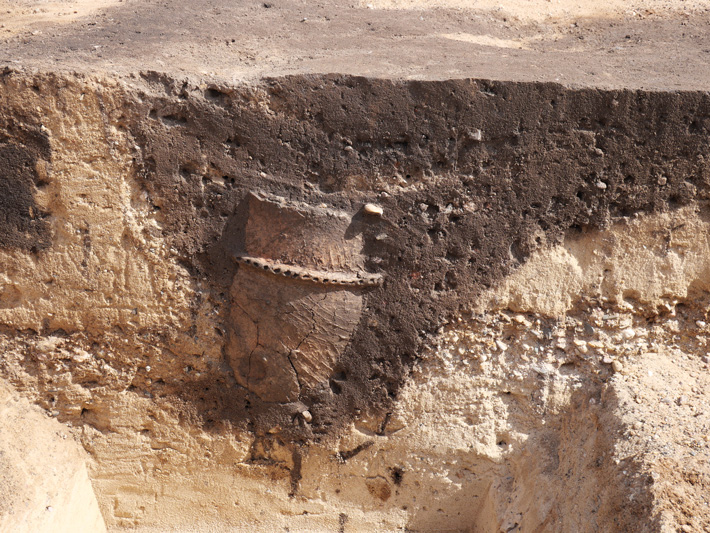

But until very recently, there was little discussion of meaningful connections between Bronze Age Britain and Germany. For much of the twentieth century, archaeologists thought of Bell Beaker as a kind of package of ideas and technology that spread across the continent by word of mouth, not by people migrating. “Models of social change tended to focus on change being internal,” Pollard says. “There wasn’t much need to reflect on the possibility of wider connections.”
As a result, British archaeologists long viewed Stonehenge and the other rings and ritual structures nearby as a local phenomenon, a British invention that had few parallels in the rest of Europe. “In the U.K., we tend to think of the late Neolithic as something quite insular,” Pollard says. The discovery of Pömmelte and other European sites prompted archaeologists to take the idea of regional connections more seriously. But it wasn’t until geneticists at Harvard University analyzed the DNA preserved in hundreds of prehistoric British skeletons in 2018 that the picture came into sharp focus.
The DNA results confirmed that Bell Beaker wasn’t a matter of cultural change, but of mass migration. Studies had already shown that people migrated from the steppes of Ukraine and Russia to central Germany around 2800 B.C., replacing the Neolithic farmers who had lived there for millennia. Shortly before construction on the final phases of Stonehenge began, about 2500 B.C., DNA results show, this same group arrived in Britain from central Europe. Their genes match those of Bell Beaker people living in the area around Pömmelte during the same time period. “Thanks to genetics, we have good evidence of human movement,” Pollard says. “From 2500 B.C., we have people coming over from continental Europe and settling in Britain.”
That understanding, coupled with the artifacts uncovered at Pömmelte, offers a new explanation of the similarities between the two sites. Both, Knoll says, were the product of a single culture that spread across Europe around 2500 B.C. and shared material culture, technology, and perhaps language. And people from the two locations were probably in regular contact.
While Stonehenge is aligned with the summer solstice sunrise, the entrances to Pömmelte’s massive rings are oriented to sunrise on the days halfway between the solstices and the equinoxes. “We call it the German Stonehenge because the beginnings are the same—it’s got the same diameter, just a different orientation,” Knoll says. “They’re built by the same people.” In fact, Stonehenge, whose first phases are slightly older than Pömmelte’s, may even have been the blueprint for the German site’s wood rings. “It’s not coincidental,” says Knoll. “It’s coming from the same culture, the same view of the world.”



